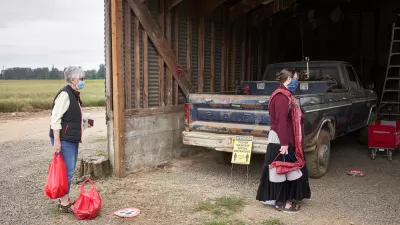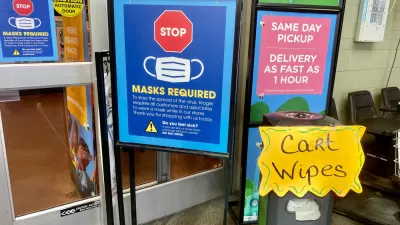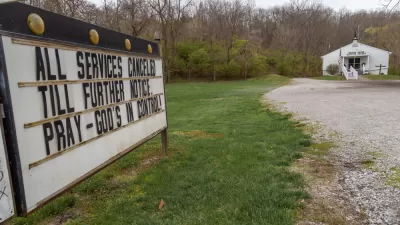Hospitals in parts of Wisconsin are experiencing a medical crisis reminiscent of New York and Arizona—they are running out of beds due to a surge of COVID-19 patients. The outbreak is statewide, showing no relationship with density.

COVID-19 is an infectious disease; it is not an urban disease. Wisconsin, which stands out in solid red on the The New York Times coronavirus map on Oct. 8, meaning at least 48 average daily cases per 100,000 people during the last week, is a good illustration of how behavior, not density, is the driver of the disease in the Midwest.
“We’re in a crisis right now and need to immediately change our behavior to save lives,” said Gov. Tony Evers (D) in a press releasing announcing a new emergency order on Oct. 7. “We are continuing to experience a surge in cases and many of our hospitals are overwhelmed, and I believe limiting indoor public gatherings will help slow the spread of this virus."
"The State of Wisconsin is in the midst of a deadly, uncontrolled, and exponentially growing spike in cases of COVID-19," states the first line of the emergency order [pdf] signed by Andrea Palm, secretary-designee of the Department of Health Services, that includes limits to stores and restaurants [pdf]. "The State is the nation's COVID-19 hot spot, and intervening measures are necessary to slow the rampage of illness and death caused by the virus."
The emergency order put the state's outbreak in the context of the nation and its geographic neighbors.
It had the third highest number of new cases in the past seven days (17,641 cases), with only California and Texas having more new cases (and 6.8 times and 5 times the population, respectively). Wisconsin is also third in the nation in new cases per 100,000 residents (303 cases per 100,000 residents in the past seven days), with only North Dakota and South Dakota having higher rates. Compared to neighboring states that have statewide mitigation efforts in place, Wisconsin's increase in cases (17,641) over the last 7 days is more than double both Minnesota's increase (7,093 cases) and Michigan's increase (6,878 cases) (New York Times, October 5, 2020).
The immediate danger, as was seen in late March and April in New York and in July in Arizona, lies with the ability of hospitals to care for the sick, the purpose of flattening the curve. "It is simply not enough to only wear a mask," pleaded Evers in his Democratic Radio Address on Oct. 8. "We need everyone to take further action to help stop the spread of this virus and flatten the curve."
Overflow field hospital to open
"The number of people hospitalized due to the virus in Wisconsin has tripled in the last month," reports Sophie Carson for the Milwaukee Journal Sentinel (source article). "Northeast and central Wisconsin continued to drive much of the surge in cases."
On Oct. 7, Evers announced that an 530-bed overflow hospital, built by the Army Corps of Engineers in the Wisconsin State Fair Park, West Allis, Wisconsin, a suburb west of Milwaukee, will begin accepting patients.
“Our hospital system is strained and in some areas of the state reaching capacity and at risk of being overwhelmed,” said Department of Health Services Secretary-designee Andrea Palm.
"Evers said he was opening the field hospital at the urging of hospital officials in Green Bay, Appleton, Neenah and Wausau who are reporting that their ICUs are at capacity," write Mary Spicuzza and Molly Beck in an earlier Journal Sentinel article. The area includes the Fox Valley cities that Carson notes prominently in the source article:
As has been the case several times in recent days, the Oshkosh-Neenah metro area topped the New York Times' ranking of worst outbreaks in the country.
The ranking looks at average daily case counts over the last two weeks on a population-adjusted basis. Also in the top five were the Appleton and Green Bay metro areas.
Where the Outbreak in the U.S. Is Worst Now
Carson is referencing the Times "Metro Areas" coronavirus case data tracker previously referenced in a post here last month, "Coronavirus College Clusters Stress Town and Gown Relationship." The number two spot was claimed by Rexburg, Idaho, in Madison County, with Bismarck, N.D. (Burleigh County) in fifth place (see related post).
The tracker looks at four ways that the coronavirus is affecting metro/micro areas. Carson noted the second: "Where the outbreak is worst now." What's striking is that the list of 20 metro/micro areas is dominated by Wisconsin, claiming eight spots. No other state held even two.
Wisconsin outbreak – everywhere
Milwaukee County is the most populous (946,000) in the Badger State, and accounts for the highest number of the new coronavirus case infections among the state's 72 counties: 264 daily new cases (7-day moving average) based on Oct. 6 data, according to the Harvard Global Health Institute/Brown University School of Public Health COVID Risk Levels Dashboard.
However, when the case incidence is considered per capita, Milwaukee is ranked #53. The state's average case incidence is 42 daily cases per 100k people (7 Day Moving Average) as of Oct. 6. Milwaukee is well below that average – 28 daily cases per 100k. The U.S. average is 13 daily cases per 100k.
Dane County, home to the state capital, Madison, and the University of Wisconsin, is a better example of how urbanity and density is not directly related the coronavirus prevalence. Even with the university having the state's largest college coronavirus cluster – over 3,000 cases according to the Times college and university coronavirus trackeron Oct. 8, the state's second most populous county holds the #62 spot in the per capita infection rate, 21 daily cases per 100k, putting it in the orange as opposed to red zone. [See "Do You Know Your COVID-19 Colors?"].
In fact, the virus is so prevalent in the Badger State that 54 counties (75%) are in the red, i.e., > 25 daily cases per 100k; 17 counties (24%) are orange: 10-24 per 100k. Only Pepin County, the fourth least populous in the state, is in the yellow: 1-9 daily new cases per 100k.
Conclusion
The Wisconsin outbreak is indeed dire. Department of Health Services Secretary-designee Andrea Palm said during a press briefing on Oct. 7, “This Is Going To Get Worse Before It Gets Better.”
As Gov. Evers stated, Wisconsinites need to change their social distancing behavior, regardless of whether they live in a rural area, suburb, or city. Hopefully his new emergency order limiting gatherings and indoor occupancy, in addition to his statewide mask mandate which was extended last month, will help flatten the curve and prevent the hospitals from being overhelmed.
Related in Planetizen:
-
Coronavirus College Clusters Stress Town and Gown Relationship, September 14, 2020
-
The Changing Geography of the Pandemic, August 27, 2020
-
Pandemic's New Phase: Spreading to Rural and Urban Areas Alike, August 9, 2020
-
Texas Hits Pause as Hospital Beds Fill Up June 26, 2020
-
Will the Coronavirus Spare Rural America? April 13, 2020

Manufactured Crisis: Losing the Nation’s Largest Source of Unsubsidized Affordable Housing
Manufactured housing communities have long been an affordable housing option for millions of people living in the U.S., but that affordability is disappearing rapidly. How did we get here?

Americans May Be Stuck — But Why?
Americans are moving a lot less than they once did, and that is a problem. While Yoni Applebaum, in his highly-publicized article Stuck, gets the reasons badly wrong, it's still important to ask: why are we moving so much less than before?

Research Shows More Roads = More Driving
A national study shows, once again, that increasing road supply induces additional vehicle travel, particularly over the long run.

Judge Halts Enforcement of Anti-Homeless Laws in Grants Pass
The Oregon city will be barred from enforcing two ordinances that prosecute unhoused residents until it increases capacity and accessibility at designated camping sites.

Advancing Sustainability in Los Angeles County Schools
The Los Angeles County Office of Education’s Green Schools Symposium brings together educators, students, and experts to advance sustainability in schools through innovative design, climate resilience strategies, and collaborative learning.

Using Old Oil and Gas Wells for Green Energy Storage
Penn State researchers have found that repurposing abandoned oil and gas wells for geothermal-assisted compressed-air energy storage can boost efficiency, reduce environmental risks, and support clean energy and job transitions.
Urban Design for Planners 1: Software Tools
This six-course series explores essential urban design concepts using open source software and equips planners with the tools they need to participate fully in the urban design process.
Planning for Universal Design
Learn the tools for implementing Universal Design in planning regulations.
City of Moreno Valley
Institute for Housing and Urban Development Studies (IHS)
City of Grandview
Harvard GSD Executive Education
NYU Wagner Graduate School of Public Service
City of Cambridge, Maryland
Newport County Development Council: Connect Greater Newport





























